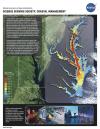You are here
Science Communication Material
NASA's Earth Observing System provides a variety of materials available for download. Feel free to choose a category below:
- Brochures
- Postcards
- Posters
- Science Writers’ Guide
- Mission Brochures
- Fact Sheets
- Calendars
- Booklets
- Lithographs
- Reference and Data Products Handbooks
- iBooks
- Activities
 |
Birth of a New Iceberg in Pine Island Bay, Antarctica (2001) This lithograph shows the break-off of a large tabular iceberg from the Pine Island Glacier in West Antarctica. This event occurred between November 4th and 12th, 2001, and provides powerful evidence of rapid changes underway in this area of Antarctica. The three images were acquired by the vertical-viewing (nadir) camera of the Multi-angle Imaging SpectroRadiometer (MISR) instrument aboard NASA’s Terra spacecraft. The dimensions of the iceberg are approximately 42 kilometers by 17 kilometers (26 miles by 11 miles). This publication appears in: |
 |
Carbon Management (2005) Carbon Dioxide (CO2) is fundamental for life on Earth. Human beings exhale CO2 as a waste product when they breathe, but plants absorb it in the life-sustaining process of photosynthesis—which human beings depend for the food we eat. CO2 is also a naturally occurring greenhouse gas (not the most efficient such gas but certainly the most abundant); its presence in the atmosphere moderates Earth’s average surface temperature and keeps nighttime temperatures from plunging to extreme cold. This publication appears in: |
 |
CERES (2001) CERES measures the balance of solar energy received by the Earth and the energy reflected and emitted back into space. Understanding the energy coming into and going out of the Earth system is critical for assessing whether scientists’ models of global climate change are making accurate predictions. This pair of images is the Terra mission’s first in an ongoing series of such measurements of our planet’s changing climate system. This publication appears in: |
 |
Coastal Management (2003) Our Earth’s coastal regions are a precious natural resource. The United States has over 95,000 miles of shoreline that provide resources for humans; homes for birds, animals and vegetation; and serves as vital ecosystems for many marine species. These shorelines are under siege from a number of natural phenomena. Global warming threatens to raise the level of the oceans and inundate our coastal lands. Harmful algal blooms (HAB), sometimes referred to as Red Tide, are caused by explosive growth of certain rare toxic species of algae, in response to excess nutrients in the water. These algae form the base of the food chain, and thus threaten fish, shellfish, birds, marine mammals, and even humans. The incidence of HAB outbreaks has increased significantly in recent years. Hypoxia refers to low dissolved oxygen concentrations on the ocean bottom that occur when excess nutrients in the water lead to elevated algae concentrations that deprive the plants and animals that dwell in deeper waters of vital life-giving oxygen. Over 7000 square miles of the Gulf of Mexico are hypoxic—the largest swath in the Western Hemisphere. The health of our shores has a major impact on our nations socioeconomic well being, as more than half of our population live in counties that border the sea. This publication appears in: |
 |
Earth at Night (2009) |
 |
Earth Day Booklet (2009) In celebration of Earth Day, NASA invites you to learn more about the agency’s commitment to understanding our changing planet by completing the activities in this booklet. This publication appears in: |
 |
Earth Observatory (2011) Find out what NASA’s Earth Observatory has to offer. This publication appears in: |
 |
Ecological Forecasting (2005) Ecological forecasting involves the use of Earth observations and models to predict the impacts of environmental changes on the ecosystems upon which we depend for our very existence. It links the physical world of climate and geology to the living world of biology and ecology. Our goal is reliable forecast models of changes in living systems with uncertainties and estimates of error explicitly stated. These models must span spatial scales from molecular to global, as well as take advantage of information across time scales to test and refine the accuracy of our predictions. NASA is currently involved in several international and domestic partnerships under the theme of ecological forecasting. This publication appears in: |
 |
Energy Management (2003) Our nation is critically dependent on stable and reliable sources of energy. Traditionally, much of this demand has been met by burning fossil fuels such as oil, coal, and natural gas, but in recent years, considerable evidence has been amassed that these fuels can impact our environment, and alternative sources of fuel have been explored. Nuclear energy has been put forth as a cleaner alternative and used successfully in a few places but this source is not without its own set of environmental concerns. Other alternatives to fossil fuels are now emerging, including renewable energy technologies (RETs) like solar energy and wind power, and biomass fuels such as corn-based ethanol and other species under development. These alternative fuel sources can help reduce mankind’s dependence on fossil fuels and, at the same time, may help to improve our quality of air. This publication appears in: |
 |
EOS Science: Air (2007) The EOS Science: Air Poster Series explains what NASA scientists are doing to study and understand air on Earth. This publication appears in: |
